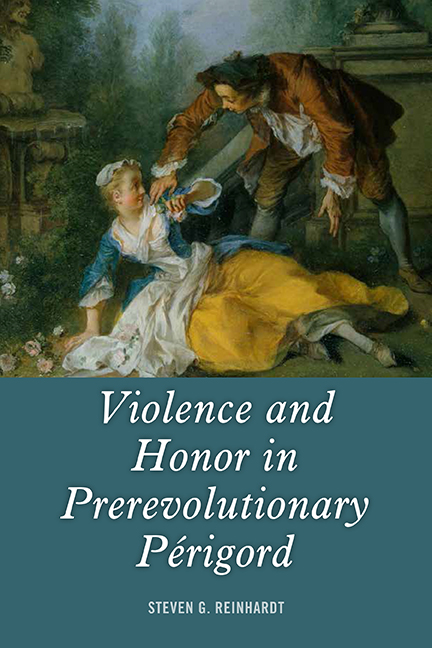Book contents
- Frontmatter
- Dedication
- Contents
- Acknowledgments
- Maps
- Introduction: “The Saint of Honor”
- 1 Violence and Honor
- 2 Honor in a Cross-Cultural Context
- 3 From Honor to Honnêteté in Old Regime Europe
- 4 “The Good Old Days” in Prerevolutionary Sarladais
- 5 “The Saint of Honor” in the Sénéchaussée of Sarlat
- 6 Women and Honor-Related Criminal Affaires
- 7 Policing Honnêteté: Shameful, Sinful, and Criminal Conduct
- 8 “Fallen Women” and Infanticide
- 9 Compromised Honor and Dangerous Liaisons
- 10 Honor and Homicide
- Conclusion
- Notes
- Bibliography
- Index
5 - “The Saint of Honor” in the Sénéchaussée of Sarlat
Published online by Cambridge University Press: 10 June 2021
- Frontmatter
- Dedication
- Contents
- Acknowledgments
- Maps
- Introduction: “The Saint of Honor”
- 1 Violence and Honor
- 2 Honor in a Cross-Cultural Context
- 3 From Honor to Honnêteté in Old Regime Europe
- 4 “The Good Old Days” in Prerevolutionary Sarladais
- 5 “The Saint of Honor” in the Sénéchaussée of Sarlat
- 6 Women and Honor-Related Criminal Affaires
- 7 Policing Honnêteté: Shameful, Sinful, and Criminal Conduct
- 8 “Fallen Women” and Infanticide
- 9 Compromised Honor and Dangerous Liaisons
- 10 Honor and Homicide
- Conclusion
- Notes
- Bibliography
- Index
Summary
Historians of early modern France have long recognized that the criminal court archives of the royal parlements and sénéchaussées/bailliages are excellent sources for analyzing the ritualized gestures and insults associated with honor-related violence. “Offensive words were hardly idle or considered harmless, since when hurled in public with defamatory intent they attacked a person's honor,” writes Farr of the seventeenth-century nobility in Dijon. Similarly for non-nobles, the records of lower-level royal courts illuminate instances of delinquency as well as the social situations and contexts in which commoners engaged in competitive interaction, that is, fighting and insulting, mostly over questions of honneur and honnêteté. This chapter examines cases drawn from the Sénéchaussée of Sarlat that illustrate how measured, ritualized, and gender-specific violence (both verbal and physical) was used to adjust the balance of honor. At the same time, the fact that a broader range of plaintiffs was increasingly incorporating recourse to royal justice into their adversarial tactics suggests that they were more inclined to distance themselves from the collectivity and advance their individual interests via the anonymous justice provided by the state.
In French royal courts, the criminal charge in question was most often that of excès or injures. In 1758, Claude-Joseph de Ferrière defines the term excès as a kind of “voie de fait, outrage or wound, mistreatment or insult, done to someone using armed force or some other advantage.” He adds that even if this crime does not result in death, the victim can demand vengeance and that it is to be punished more or less rigorously, depending on the circumstances and the quality of the persons involved. If the excès is committed on a grand chemin or other public place belonging to the king, it is considered a royal case and can be judged only by a royal court; if it is committed on a byroad, however, it is not a royal case and can be handled by a seigneurial court of high justice. The lawyer Dareau, in his 1775 treatise, defines injure in the following terms: “We will call injure that which is said, written, or done with the motive of offending someone's honor, his person, or his goods.”
- Type
- Chapter
- Information
- Violence and Honor in Prerevolutionary Périgord , pp. 95 - 118Publisher: Boydell & BrewerPrint publication year: 2018

